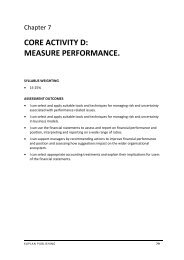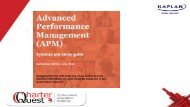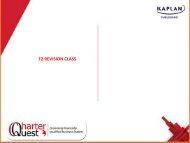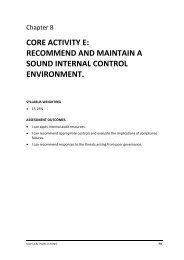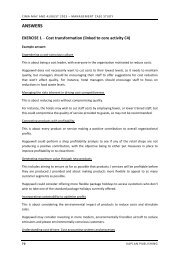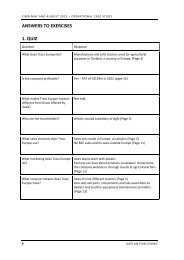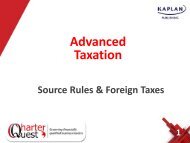You also want an ePaper? Increase the reach of your titles
YUMPU automatically turns print PDFs into web optimized ePapers that Google loves.
<strong>TX</strong> - <strong>ZAF</strong><br />
Value Added Tax<br />
1
Outcomes<br />
Upon the successful completion of this Study Unit<br />
you should be able to:<br />
• Calculate the <strong>VAT</strong> payable or refundable for a<br />
relevant tax period;<br />
• List the registration requirements and apply these<br />
requirements to a given set of facts;<br />
• Select the most important definitions in the <strong>VAT</strong><br />
Act and motivate the choice/s;<br />
• Explain what accounting bases may be used and<br />
explain which bases to apply for;<br />
• Explain <strong>VAT</strong> consequences to a Tax payer
Introduction<br />
• Levied ito Value-Added Tax Act 89 of 1991<br />
• At what rate is <strong>VAT</strong> levied?<br />
• <strong>VAT</strong> is an Indirect tax<br />
What does<br />
this mean?<br />
User acquiring<br />
goods/services<br />
Supplier/Vendor<br />
SARS<br />
• Prices must include <strong>VAT</strong>, unless specifically broken<br />
down into value and <strong>VAT</strong>
Calculation of <strong>VAT</strong><br />
Output tax<br />
• D<br />
Input tax<br />
Tax payable/refundable
<strong>VAT</strong> admin<br />
Accounting basis<br />
2 Accounting bases that may be applied by a<br />
vendor to account for <strong>VAT</strong><br />
• Invoice basis<br />
• Payments basis<br />
Determines time<br />
of supply
Invoice basis<br />
Account for <strong>VAT</strong>:<br />
Earlier of:<br />
• invoice is issued<br />
OR<br />
• any payment is received<br />
Exception<br />
When payment is received<br />
Supply of fixed property
Example<br />
A vendor registered on the invoice basis supplied the<br />
following goods:<br />
(a) On 2 February goods are delivered at one of the<br />
clients’ premises and the invoice for the goods was<br />
issued on the same date. The payment for the goods was<br />
received on 31 March.<br />
(b) On 29 April a client paid R100 000 for goods<br />
delivered on the same date. The invoice was issued on<br />
14 May.<br />
You are required to determine the time of the above<br />
supplies for <strong>VAT</strong> purposes.
Solution<br />
(a) Earlier of:<br />
• invoice is issued (2 February)<br />
• any payment is received (31 March)<br />
OR<br />
= 2 February<br />
(b) Earlier of:<br />
• invoice is issued (14 May)<br />
• any payment is received (29 April)<br />
OR<br />
= 29 April
Payment basis<br />
Account for <strong>VAT</strong>:<br />
• Payment date<br />
MUST use invoice basis for goods/services supplied of ≥<br />
R100 000 (incl. <strong>VAT</strong>)<br />
N/A to fixed<br />
property<br />
• Who may account for <strong>VAT</strong> on the payments basis?<br />
Public authorities,<br />
municipalities etc.
Example<br />
A vendor registered on the payments basis supplied the following<br />
goods:<br />
(a) On 2 February goods were delivered at one of the clients’<br />
premises and the invoice for R15 000 for the goods was issued on the<br />
same date. The payment for the goods was received on 31 March.<br />
(b) On 29 April a client paid R50 000 for goods delivered on the same<br />
date. The invoice for the goods was issued on 14 May.<br />
(c) On 19 July trading stock was delivered at a client’s premises and<br />
the invoice for R180 000 was issued on the same date. Payment for<br />
the goods was only received on 31 August.<br />
You are required to determine the time of the above supplies for<br />
<strong>VAT</strong> purposes.
Solution<br />
(a) Value of supply < R100 000 = payment<br />
received – 31 March.<br />
(b) Value of supply < R100 000 = payment<br />
received – 29 April.<br />
(c) Value of supply > R100 000<br />
the time of supply is determined by applying<br />
the rules for the invoice basis: the earlier of<br />
payment or the date the invoice is issued - 19<br />
July.
Tax periods (s 27)<br />
Tax period<br />
Category A:<br />
Category B:<br />
Category C:<br />
Category D:<br />
2 month periods ending uneven months (Jan, March, May etc.)<br />
Taxable supplies ≤ R30mill / farmers with taxable supplies > R1,5mill in a<br />
12 month period<br />
2 month periods ending even months (Feb, April, June etc.)<br />
Taxable supplies ≤ R30mill / farmers with taxable supplies > R1,5mill in a<br />
12 month period<br />
Monthly periods<br />
Taxable supplies > R30 million in a 12 month period<br />
Six month periods, ending Feb/Aug<br />
Farmers with taxable supplies of < R1,5 million in 12 month period
Tax periods (s 27) (cont.)<br />
Tax period<br />
Category E:<br />
Category F:<br />
Annual periods, ending on last day of y.o.a<br />
Companies and trust funds whose activities consist solely of<br />
– the letting of fixed property or movable goods to, or<br />
– the administration or management of companies that are connected<br />
Four month periods, ending Jun/Oct/Feb<br />
Value of supplies
Definitions
Definition – when will a transaction<br />
attract <strong>VAT</strong>?<br />
There should be:<br />
1<br />
• a supply<br />
2<br />
• of goods or services<br />
3<br />
• by a vendor<br />
4<br />
• in the course or furtherance of an enterprise
Supply<br />
1<br />
To provide or to make available (dictionary)<br />
Defined in s1<br />
• includes a sale, rental agreement, an instalment<br />
credit agreement….<br />
• 2 persons involved (supplier and recipient)<br />
• includes supplies for consideration other than<br />
money
Goods or services<br />
2<br />
"Goods" are defined as:<br />
• corporeal movable things<br />
Things that can<br />
be touched<br />
• fixed property<br />
• any real right in the above (e.g. usufruct)<br />
• electricity<br />
Excl. Money, revenue stamps, certain rights
Goods or services<br />
2<br />
"Services" are defined as:<br />
Anything done<br />
or to be done<br />
• granting, cession or surrender of any right or the<br />
making available of any facility or advantage<br />
• if not a supply of goods, then a service (incl.<br />
trademarks, goodwill, patents and know-how)
3<br />
By a vendor<br />
Person registered/required to be registered under the <strong>VAT</strong> act<br />
Includes:<br />
• Company, CC<br />
• Body of persons<br />
(partnership)<br />
• Deceased/insolvent<br />
estate etc.<br />
Group of<br />
companies?<br />
Who is required to<br />
register ito the <strong>VAT</strong><br />
act?<br />
To register: fully complete a <strong>VAT</strong> 101 form, which is obtainable from<br />
SARS’s website (http://www.sars.gov.za)
3<br />
By a vendor(cont.)<br />
Registration as a vendor: Compulsory registration:<br />
• At end of month if taxable supplies > R1m for 12 months<br />
• At beginning of month, if it is anticipated that taxable supplies<br />
for the next 12 months will be > R1m<br />
• Foreign suppliers: at end of month if taxable supplies > R50 000<br />
for 12 months<br />
Branches/<br />
divisions<br />
Excl. <strong>VAT</strong><br />
any consecutive period of<br />
12 months<br />
Person carries on two separate businesses, he must register when the<br />
joint taxable supplies of the two businesses > R1m<br />
S 50 A may deem separate persons as ONE – anti avoidance.
Example<br />
Mrs Z carries on three different enterprises that only make<br />
taxable supplies. All three enterprises are carried on in her<br />
own name.<br />
• Enterprise 1: Turnover of R360 000 for 12 months<br />
(excluding <strong>VAT</strong>)<br />
• Enterprise 2: Turnover of R320 000 for 12 months<br />
(excluding <strong>VAT</strong>)<br />
• Enterprise 3: Turnover of R340 000 for 12 months<br />
(excluding <strong>VAT</strong>)<br />
Determine whether Mrs Z is obliged to register for <strong>VAT</strong><br />
purposes if the above information applies to the 12 months<br />
ending 31 December 2014.
Solution<br />
• Total turnover = R 1 020 000<br />
• This > R1 000 000<br />
• Mrs Z has to register as a <strong>VAT</strong> vendor
3<br />
By a vendor (cont.)<br />
Registration as a vendor: Voluntary registration:<br />
• Taxable supplies > R50 000 for 12 month period<br />
• Commercial accommodation > R60 000<br />
• Taxable supplies expected to be > R50 000 in the next 12<br />
months (payments basis until > R50 000)<br />
• Person continuously and regularly carries on activity and<br />
it is reasonably expected that value of taxable supplies ><br />
R50 000 in 12 month period
4<br />
In the course or furtherance of an<br />
enterprise<br />
Definition of an enterprise<br />
Not<br />
once-off<br />
• any enterprise/activity<br />
• carried on continuously or regularly (ongoing activity)<br />
• in SA or partly in SA<br />
• by any person<br />
• in the course /furtherance of which<br />
• goods or services are supplied for a consideration,<br />
• Deposit – only consideration if applied/forfeited<br />
• Donation to any association not for gain is specifically excl.<br />
from the def of ‘consideration’<br />
• whether for profit or not.<br />
In money/<br />
otherwise
4<br />
In the course or furtherance of an<br />
enterprise<br />
Specifically excluded from the definition of an enterprise<br />
• Supply of services by an employee to his employer<br />
• Hobbies<br />
• Exempt supplies<br />
• Commercial accommodation if value of supply<br />
≤ R60 000 for a period of 12 months
Refusal to register<br />
SARS can refuse to register a person if any of the<br />
following apply:<br />
– Person has no fix place of business<br />
– Person does not keep proper accounting records<br />
for is enterprise<br />
– The person does not a bank account for his<br />
enterprise<br />
– The person’s <strong>VAT</strong> registration was previously<br />
cancelled due to him not performing his duties<br />
under the <strong>VAT</strong> Act<br />
26
Output <strong>VAT</strong><br />
PAYABLE on the supply BY the vendor
Output <strong>VAT</strong><br />
1<br />
Types of supplies<br />
2<br />
Taxable supply<br />
Exempt supply<br />
Standardrated<br />
supply<br />
Zero- rated<br />
supply<br />
No <strong>VAT</strong><br />
15%<br />
IF<br />
Input denied<br />
0% if input tax has been<br />
denied<br />
then no output tax is<br />
levied on the supply
Calculation of output tax - example<br />
Vendor Ltd’s sales (all standard-rated taxable<br />
supplies) for a specific tax period amounted to<br />
R45 600 (including <strong>VAT</strong>).<br />
You are required to calculate output tax in<br />
respect of the supplies.<br />
R45 600 x 15/115 = R5 947.83
The levying of output <strong>VAT</strong><br />
Output tax is<br />
levied on<br />
• the supply of goods, or services by a vendor in<br />
the course or furtherance of an enterprise<br />
• imported goods , or<br />
• imported services
Zero-rated supplies (s11)
Zero-rated supply: Exported goods<br />
Definition of 'exported':<br />
Goods delivered<br />
in export country<br />
Ownership<br />
changes in SA<br />
• Direct/ indirect exports, or<br />
0% N/A – 2 nd hand goods if<br />
notional input was claimed<br />
Supply – subject to <strong>VAT</strong> @ 15%<br />
Recipient entitled to refund<br />
• goods delivered to owner of a foreign-going<br />
ship / aircraft, or<br />
If used on<br />
ship/aircraft<br />
• goods supplied under a rental agreement<br />
If used in export country/<br />
customs controlled area
Example<br />
Mr Strempel is a non-resident on vacation in South Africa.<br />
Whilst touring the Kruger National Park, he decided to<br />
purchase a wooden giraffe figure. The curio store charged<br />
him R3 363 for the novelty item, including <strong>VAT</strong> at the<br />
standard rate. Mr Strempel and his giraffe figure continued to<br />
tour the country for another two weeks before his leave<br />
entitlement ran out and he needed to return to his home<br />
country Germany. Mr Strempel took the giraffe figure along<br />
when he left South Africa.<br />
Explain the <strong>VAT</strong> consequences for Mr Strempel, the curio<br />
store, and the position of SARS.
Solution<br />
• Mr Strempel would have initially paid <strong>VAT</strong> of<br />
R439 (R3 363 × 15/115) when purchasing the<br />
giraffe figure from the curio store. The curio<br />
store, being a <strong>VAT</strong> vendor, needs to charge the<br />
output tax of R439 and pay it over to SARS. Upon<br />
leaving the country with the wooden giraffe, Mr<br />
Strempel can have the <strong>VAT</strong> of R439 refunded to<br />
him. SARS needs to refund this amount on Mr<br />
Strempel’s departure with the item purchased in<br />
South Africa, as it is regarded as being an indirect<br />
export in terms of the Export Incentive Scheme.
Zero-rated supply: Exported services<br />
Transportation (s 11(2)(a))<br />
If transported from: (at least one leg outside SA)<br />
Outside SA to Outside SA<br />
In SA to Outside SA<br />
Outside SA to in SA<br />
Insurance on above - also zero-rated (s 11(2)(d)).
Zero-rated supply: Exported services<br />
Services rendered outside South Africa (s 11(2)(k))<br />
If<br />
• physically rendered outside SA/<br />
• Customs controlled area<br />
Services to non-residents (s 11(2)(l ))<br />
If non-resident is not in SA @ time services are rendered<br />
Zero rating N/A if the service is directly in connection with<br />
• land, or improvements thereto, situated in SA, or<br />
• movable property situated inside SA at the time the services are<br />
rendered<br />
– Still zero rated if exported subsequent to supply of service
Example<br />
Vendor A is instructed to replace the screen of a<br />
laptop computer belonging to a visiting tourist.<br />
The supply by the vendor may not be zero-rated<br />
because the laptop is within the borders of<br />
South Africa. If, however, the laptop is again<br />
exported directly after the supply, the zerorating<br />
may be applied.
Zero-rated supply: other<br />
• Supply of goods and services for use for agricultural or other<br />
farming purposes (s 11(1)(g))<br />
– Example: seed, feed, fertiliser, etc.<br />
• Supply of gold coins issued by the Reserve Bank (s 11(1)(k))<br />
– Example: Kruger Rands<br />
• Certain basic foodstuffs (s 11(1)(j))<br />
– Example: brown bread, maize meal, samp, mealie rice, rice,<br />
pilchards, milk and milk powder, fresh fruit and vegetables (including<br />
mealies, but excluding popcorn), vegetable oil (excluding olive oil),<br />
eggs and lentils<br />
• The supply of fuel levy goods (ss 11(1)(h))<br />
– Example: petrol and diesel<br />
• Charging of municipal rates by municipality (ss 11(1)(w))<br />
– Property rates and taxes @0%<br />
– Water, electricity, refuse removal @ 15%<br />
– If charged @ flat rate – not zero rated
Example<br />
Mark Model (a <strong>VAT</strong> vendor) carries on the business of a<br />
dairy, and for the <strong>VAT</strong> period under review he received<br />
R300 000 (<strong>VAT</strong> inclusive) for the sale of milk. During the<br />
same period he incurred the following expenses (<strong>VAT</strong><br />
inclusive):<br />
R<br />
Purchase of cows from vendors 114 000<br />
Fuel 8 000<br />
Purchase of packing materials 57 000<br />
Calculate the <strong>VAT</strong> payable or refundable for the<br />
applicable <strong>VAT</strong> period.
Output tax<br />
Sale of milk (zero-rated)<br />
Input tax<br />
Solution<br />
Purchase of cows (R115 000 × 15/115) 15 000<br />
Fuel (zero-rated)<br />
Purchase of packing materials (R57 000 × 15/115) 7 435<br />
Total input tax 22 435<br />
An amount of R22 435 is to be refunded by SARS (Rnil – R22 435) (22<br />
435)<br />
Note<br />
It should be clear from the example that although Mark Model made zero-rated<br />
supplies, these supplies are also regarded as taxable supplies and that he will still<br />
be able to claim the input tax incurred in making these supplies.<br />
nil<br />
nil
Zero-rated supply: The sale of a going<br />
concern (s 11(1)(e))<br />
Requirements<br />
• Parties agreed in writing that enterprise, or part<br />
thereof, is disposed of as a going concern<br />
• Parties have at the time of conclusion of the contract<br />
agreed in writing that the enterprise will be an incomeearning<br />
activity on the date of its transfer<br />
• All the assets necessary for carrying on the enterprise<br />
are disposed of by the supplier to the recipient<br />
• The parties have at the time of the contract agreed in<br />
writing that the consideration for the supply is inclusive<br />
of <strong>VAT</strong> at the rate of 0%.<br />
• Both the parties (supplier and recipient) must be<br />
registered vendors for <strong>VAT</strong> purposes
Exempt supplies
Output tax: Exempt supplies (s 12)<br />
• No output tax on exempt supplies<br />
AND<br />
• No input tax relating to the expenditure on<br />
these supplies may be claimed
Output tax: Exempt supplies (s 12)<br />
l<br />
Financial services (ss 2 and 12(a))<br />
Examples:<br />
• issue of a loan,<br />
• sale of shares<br />
• interest paid<br />
NOT financial services:<br />
• Fee based financial services<br />
e.g. Bank charges<br />
• Supply of a cheque book
Example<br />
The following items appeared on Ragdoll Boutique’s bank<br />
statements for September:<br />
R<br />
Internet banking fee 73,92<br />
Service fee (bank charges) 162,35<br />
Transaction costs 83,90<br />
Administration costs 14,00<br />
Interest charged on overdraft 116,40<br />
Interest received on positive bank balance 83,20<br />
Cheque book – cost 18,20<br />
Indicate which of the above amounts include <strong>VAT</strong> and, if<br />
so, how much <strong>VAT</strong> is included.
Solution<br />
Internet banking fee (R73,92 × 15/115)<br />
Service fee (R162,35 × 15/115)<br />
Transaction costs (R83,90 × 15/115)<br />
Administration costs (R14,00 × 15/115)<br />
Interest charged on overdraft<br />
Interest received on positive bank balance<br />
Cost for cheque book (R18,20 × 15/115)<br />
nil<br />
nil
Output tax: Exempt supplies (s 12)<br />
l<br />
Donated goods and services (s 12(b))<br />
• Donations by an association not for gain OR<br />
• Goods being supplied were made/manufactured by<br />
the association, provided that at least 80% of the value<br />
of the materials used consists of donated goods.
Example<br />
The Needy Association, an association not for gain,<br />
received second-hand clothes and glasses as<br />
donations from members of the public. The Needy<br />
Association sells the clothes to the public for R10 a<br />
piece and engraved the Association’s name on the<br />
glasses prior to selling them to the public for R5 a<br />
glass.<br />
Determine the output <strong>VAT</strong> consequences of the<br />
above.
Solution<br />
The supply of the clothes as well as the glasses<br />
will be exempt from <strong>VAT</strong>, since at least 80% of<br />
the value of these goods consisted of donated<br />
goods.
Output tax: Exempt supplies (s 12)<br />
l<br />
Accommodation (s 12(c))<br />
Residential accommodation = EXEMPT<br />
Example: supply of a house / flat to another person who<br />
will use the house or flat mainly for residential purposes<br />
Commercial accommodation = <strong>VAT</strong> @ 15%<br />
Examples:<br />
• Board and lodging, together with domestic goods and<br />
services, in any house, flat, hotel, guesthouse, holiday<br />
accommodation AND annual receipts > R120 000 in<br />
12 months/ expected to > R120 000 in 12 months<br />
• Lodging in home for the aged
Output tax: Exempt supplies (s 12)<br />
l<br />
Value of supply<br />
Commercial accommodation<br />
Accommodation & domestic<br />
goods/services supplied ≤ 28 days =<br />
FULL VALUE<br />
Accommodation & domestic<br />
goods/services supplied @ all-inclusive<br />
rate for unbroken period of > 28 days =<br />
60% OF ALL-INCLUSIVE CHARGE<br />
Where separate prices are charged for accommodation and other<br />
services <strong>VAT</strong> levied @ 100% for other services and 60% for<br />
accommodation<br />
Domestic goods/services: example - cleaning and<br />
maintenance, meals, laundry, furniture, television set etc.
Example<br />
Hein is the owner of Rest-a-While, a bed and breakfast<br />
establishment situated in the Natal Midlands.<br />
His total annual receipts from the bed and breakfast<br />
business amount to R130 000. Most of the guests do not<br />
stay longer than three nights at a time. It does<br />
sometimes happen that a guest stays a month at a time.<br />
Hein charges R220 per night (excluding <strong>VAT</strong>) for bed and<br />
breakfast.<br />
Explain to Hein the <strong>VAT</strong> consequences of running his<br />
bed and breakfast business.
Solution<br />
The B & B business constitutes the provision of commercial accommodation. As the<br />
annual receipts of the business exceed R120 000, Hein can register voluntarily for <strong>VAT</strong> (still<br />
below the mandatory registration threshold of R1 million).<br />
Should Hein decide to register, he will have to levy output tax on the supply of the<br />
domestic goods and services (being a taxable supply) as follows:<br />
• guests staying 28 days and less: 100% of the charge is subject to <strong>VAT</strong> at 15% (for<br />
example three nights at R220 × 100% × 15% = R99 output tax), and<br />
• guests staying more than 28 days at a time: only 60% of the charge is subject to <strong>VAT</strong> at<br />
15% (for example 30 nights at R220 × 60% × 15% = R594 output tax).<br />
Hein will be entitled to an input tax deduction for <strong>VAT</strong> paid on the acquisition of goods<br />
and services for the purposes of the B & B business. This is because he is making taxable<br />
supplies.<br />
Should Hein decide not to register for <strong>VAT</strong> purposes, he does not have to account for<br />
output tax, but then he will not be entitled to any input tax deductions.
Example<br />
Jo Ndlovu is a property magnate and a vendor. During the current tax<br />
period Jo earned the following amounts:<br />
Letting of townhouses (purely for residential purposes) 42 000<br />
Short-term stay (less than 28 days) in bed and<br />
breakfast hotels (including <strong>VAT</strong>) 15 000<br />
Board and lodging in boarding houses (all periods<br />
longer than 28 days – excluding <strong>VAT</strong>) 30 000<br />
R<br />
Calculate the output tax in respect of the income earned.
Solution<br />
Letting of townhouse, hiring of a dwelling,<br />
which is an exempt residential supply<br />
Rnil<br />
Bed and breakfast, commercial accommodation<br />
R15 000 × 15/115= 1 956.52<br />
Board and lodging, long-term commercial<br />
accommodation (R30 000 × 15% × 60%) 2 700
Example<br />
Assume the all-inclusive daily rate at a hotel is<br />
R500 per day (excluding <strong>VAT</strong>). Included in the<br />
R500 daily rate is the use of a post-box.<br />
Calculate the <strong>VAT</strong> if<br />
(a) the person stays in the hotel for four days,<br />
and<br />
(b) the person stays in the hotel for 35 days.
Solution<br />
(a) Full supply at standard rate (R500 × 4 × 15%)<br />
– output tax<br />
(b) Supply of the post box that is included in the<br />
all-inclusive daily rate – output tax nil<br />
Supply of commercial accommodation together<br />
with domestic goods and services (R500 × 35 ×<br />
60% × 15%) – output tax
Other exempt supplies<br />
Transport of fare-paying passengers and their personal effects by road<br />
or railway within SA in a bus or taxi (not a game-viewing vehicle )<br />
• N/A to air tickets (only road or railway)<br />
• N/A for courier service (passengers and personal belongings, not<br />
goods)<br />
• N/A if not charged separately for it (fare-paying)
Other exempt supplies<br />
Remember:<br />
• Travel by road or railway of fare-paying passengers within SA is<br />
an exempt supply.<br />
• Travel by air when any leg of the ticket is outside SA, is a zerorated<br />
supply.<br />
• Travel by air in SA is a standard rated supply.<br />
• Travel in a game viewing vehicle or hearse is subject to <strong>VAT</strong> at<br />
the standard rate.
Other exempt supplies (cont.)<br />
• Supply of qualifying educational services by the State, a<br />
school, a public higher education institution (s 12(h)(i))<br />
• The supply by a school, university, technikon or college,<br />
solely or mainly for the benefit of its learners, of goods<br />
or services (including domestic goods or services) for a<br />
consideration in the form of school fees, tuition fees or<br />
payment for board and lodging (s 12(h)(ii))<br />
• Membership contributions to employee organisations,<br />
such as trade unions (s 12(i))<br />
• The supply of childcare services by a crèche or an afterschool<br />
care centre (s 12(j))
Input <strong>VAT</strong><br />
Can't claim <strong>VAT</strong> if not<br />
used for making taxable<br />
supplies = DENIED<br />
Claim input <strong>VAT</strong><br />
To extent consumed for<br />
purposes of making<br />
taxable supply<br />
May claim:<br />
Input tax amount<br />
x<br />
% taxable supplies<br />
(apportion)<br />
If ≥ 95%, deem 100%<br />
See next slide<br />
Tax<br />
invoice<br />
Only claim if:<br />
• Have necessary documentation<br />
• Purchased from a vendor (except 2 nd hand goods)<br />
Can't claim<br />
as no <strong>VAT</strong><br />
was charged
INPUT <strong>VAT</strong><br />
Payment of goods and services<br />
supplied TO the vendor for making taxable supplies<br />
RECEIVABLE by the vendor
Tax invoices (ss 16(2) and 20)<br />
• Tax invoice should be issued for supply > R50<br />
• Must supply invoice within 21 days<br />
of the date of supply
Tax invoices<br />
Where supply > R5 000 the following must appear on the<br />
tax invoice: – must be in R (except if zero-rated)<br />
Supply > R5 000<br />
the words ‘tax invoice’<br />
name, address and <strong>VAT</strong> registration number of supplier<br />
name, address and <strong>VAT</strong> registration number of recipient<br />
invoice number & date<br />
description of the goods or services supplied<br />
Quantity/volume of the goods or services supplied<br />
either: the value of the supply, <strong>VAT</strong> charged and consideration OR<br />
consideration paid, <strong>VAT</strong> amount/statement that <strong>VAT</strong> charged & rate
Tax invoices<br />
Where supply ≤ R5 000 the following must appear on the<br />
tax invoice: – must be in R<br />
Supply ≤ R5 000<br />
the words ‘tax invoice’<br />
name, address and <strong>VAT</strong> registration number of supplier<br />
invoice number & date<br />
quantity/volume of the goods or services supplied<br />
either: the value of the supply, <strong>VAT</strong> charged and consideration OR<br />
consideration paid, <strong>VAT</strong> amount/statement that <strong>VAT</strong> charged & rate
Debit/Credit notes<br />
When a<br />
supply is<br />
cancelled<br />
Amount <strong>VAT</strong> on tax invoice < actual <strong>VAT</strong> charged = issue a debit note<br />
Amount <strong>VAT</strong> on tax invoice > actual <strong>VAT</strong> charged = issue a credit note<br />
Charged output tax<br />
on supply<br />
previously<br />
Claimed input tax<br />
previously<br />
Δ in amount of output tax that<br />
should be charged (necessary<br />
documentation)<br />
Δ in amount of input tax that<br />
should be claimed (necessary<br />
documentation)<br />
Output ><br />
Additional<br />
output tax<br />
Output <<br />
Claim<br />
input tax<br />
Input ><br />
Additional<br />
input tax<br />
Input <<br />
Pay output<br />
tax
Method of apportionment - Turnoverbased<br />
method<br />
• Total taxable supplies being expressed as a % of total supplies<br />
Formula:<br />
A = B × C/D where:<br />
A = deductible input tax<br />
B = total input tax<br />
C = value of taxable supplies<br />
Amounts<br />
excl. <strong>VAT</strong><br />
D = value of all supplies (taxable and exempt)<br />
% taxable usage (C/D) is calculated once per year – used to apportion
Special apportionment method<br />
• Vendor may use an alternative apportionment<br />
method<br />
– For example the floor space method, the<br />
transaction based method and the employee time<br />
method<br />
• If the turnover-based method does not yield a<br />
fair approximation of the extent of taxable<br />
supplies<br />
• Prior approval by SARS.
Denial of<br />
input tax
Input Tax: Denial of input tax (s17(2)<br />
Entertainment<br />
Motor cars<br />
Club membership fees and<br />
subscriptions
Denial of input tax: Entertainment<br />
• Provision of:<br />
Definition<br />
– Food/beverages<br />
– Accommodation<br />
– Entertainment/amusement
Denial of input tax: Entertainment<br />
Input NOT denied:<br />
• Entertainment business if:<br />
– Amount charged covers all direct and indirect costs or = open-MV<br />
– No amount charged but for for bona fide promotional purposes<br />
– Any excess food, not consumed by the customers during a taxable<br />
supply, is subsequently given to employees/welfare organisations<br />
• Any meal/accommodation to an employee required to be away<br />
from his usual place of residence and work ≥ 1 night.<br />
• Vendors operating taxable (not exempt) passenger transport<br />
services.<br />
• Vendors organising seminars/similar events for reward.<br />
• Vendors who receive bets in respect of the outcome of a race or<br />
any other event where the entertainment is continuously<br />
supplied as a prize to its customers.
Denial of input tax: Club membership<br />
fees and subscriptions<br />
• fees or subscriptions for membership<br />
of any club/association of a sporting…<br />
• input not denied:<br />
– Professional membership of the<br />
accounting profession
Denial of input tax: Motor cars<br />
Definition of a motor car<br />
Includes<br />
Motor vehicle<br />
Station wagon<br />
Minibus<br />
Double-cab light delivery vehicle<br />
Any other motor vehicle normally used on<br />
public roads, that has 3/more wheels for<br />
carriage of passengers<br />
INPUT<br />
DENIED
Denial of input tax: Motor cars<br />
Definition of a motor car<br />
Excludes<br />
Vehicles capable of transporting only 1 person / > 16 persons<br />
Vehicles ≥3 500 kg<br />
Caravans<br />
Ambulances<br />
Vehicles not capable of transporting passengers<br />
Game-viewing vehicles (carry ≥ 7 passengers for game-viewing)<br />
Hearses
Denial of input tax: Motor cars<br />
Complies with def of motor car = INPUT DENIED<br />
can claim input<br />
Exceptions – when a vendor is:<br />
A car-dealer<br />
Runs a car-hire business<br />
Acquired vehicle to award as a prize<br />
Are allowed to claim input on insurance/maintenance of a motor vehicle<br />
Except if not separately indicated on tax invoice – then denied
Deemed input tax on second-hand<br />
goods (ss 1, 18(8) and 20(8))<br />
• Second-hand goods<br />
• Acquired from a non-vendor in SA<br />
• May claim deemed input <strong>VAT</strong><br />
• 15/115 x lessor of purchase price/open-MV<br />
(even though no <strong>VAT</strong> has been paid)<br />
Goods previously<br />
owned and used<br />
Excl. animals and goods<br />
containing gold<br />
• Claimed to the extent payment has been made<br />
Incl.<br />
<strong>VAT</strong>
Example: Second hand goods<br />
Simuyne (Pty) Ltd, a vendor for <strong>VAT</strong> purposes,<br />
acquired a second-hand delivery bicycle from a<br />
non-vendor for use in its business. The<br />
purchase price of the delivery bicycle was R630<br />
and the market value was R780. The purchase<br />
price was paid in full.<br />
Determine whether any input tax may be<br />
claimed in respect of the purchase.
Solution<br />
Because the vendor has purchased a second-hand<br />
bicycle from a person not registered for <strong>VAT</strong> purposes, a<br />
deemed input tax credit can be claimed for the secondhand<br />
bicycle. The deemed input tax credit is based on<br />
the lower of the consideration paid (R630) or openmarket<br />
value (R780).<br />
The deemed input tax is calculated as follows:<br />
Tax fraction × consideration paid<br />
15/115 × R630 = 82.17
Second-hand goods exported<br />
Zero rating N/A if notional input was claimed<br />
by vendor/connected person of the vendor<br />
Value of supply<br />
purchase price of supplier<br />
If supplier purchased<br />
goods from<br />
connected person<br />
who claimed deemed<br />
input<br />
Greater of purchase price to<br />
vendor/connected person<br />
Zero-rating only<br />
applies to mark-up
Example: Second hand goods<br />
exported<br />
ABC CC buys scrap metal from a non-vendor for<br />
R6 000 and claims a deemed input tax<br />
deduction of R737 (R6 000 × 15/115).<br />
Explain the <strong>VAT</strong> consequences if:<br />
(a) ABC CC exports the goods for R7 000, and<br />
(b) ABC CC exports the goods for R4 000.
Solution<br />
(a) ABC CC will be required to account for output<br />
tax equal to the notional input tax claimed of R737.<br />
The output tax is based on the purchase price,<br />
irrespective of the selling price.<br />
(b) ABC CC will again be required to account for<br />
output tax equal to R737, although the selling price<br />
of the goods is less than the purchase price. The<br />
output tax is based on the original purchase price,<br />
irrespective of the selling price.
Example: Connected persons<br />
A buys second-hand goods for R2 000 and<br />
claims a notional input tax deduction of R246,<br />
then sells them to B, a connected person, for R1<br />
800. B claims an input tax deduction of R221<br />
based on the tax invoice provided by A. B<br />
exports the goods for R1 980.<br />
Explain the <strong>VAT</strong> consequences in respect of the<br />
export.
Solution<br />
B will be required to account for output tax of<br />
R246 which is equal to the deemed input tax<br />
claimable by A, a connected person.
Example<br />
Speedy purchased a motor car, a coffee machine for the canteen<br />
and a printer. He paid the following for these items:<br />
• Motor car: R143 000 (including <strong>VAT</strong> – input tax denied)<br />
• Coffee machine: R457 (including <strong>VAT</strong> – input tax denied)<br />
• Printer: R6 900 (including <strong>VAT</strong>)<br />
He then sells all three items.<br />
Explain the <strong>VAT</strong> consequences relating to the purchase and sale<br />
of the motor car, coffee machine and the printer.
Solution<br />
Provided Speedy acquired the printer for the purposes of<br />
making taxable supplies, he will be able to claim an input<br />
tax deduction on the acquisition of the printer amounting<br />
to R900 (R6 900 × 15/115). No input tax will be claimable<br />
on the acquisition of the motor car and coffee machine, as<br />
input tax deductions are specifically denied on the<br />
acquisition thereof.<br />
Speedy will be required to levy output tax on the sale of<br />
only the printer, since the said supply will be made in the<br />
course or the furtherance of his enterprise. Speedy will not<br />
be required to account for any output tax on the sale of<br />
the coffee machine and motor car, since Speedy was<br />
denied input tax deductions on the acquisition of these<br />
items.
Special rules<br />
• Instalment credit agreements and<br />
• Fixed property
Special rules – Instalment credit<br />
agreements<br />
Instalment credit agreements<br />
Suspensive sales and finance leases<br />
• supply for payment in future/instalments over a period<br />
• payment incl. finance charges<br />
• amount payable > cash value of supply (sold @ profit)<br />
Risk of ownership<br />
passes to purchaser<br />
Difference<br />
Suspensive sale<br />
• date when terms of agreement has been<br />
complied with<br />
Finance lease<br />
• date lease agreement has been concluded
Special rules – Instalment credit<br />
agreements<br />
Instalment credit agreements<br />
Value of the supply<br />
Cash sale value (excl interest)<br />
Why?<br />
Time of the supply<br />
Earlier of<br />
• Payment<br />
• Delivery<br />
Exception<br />
If the buyer has the right to return the<br />
goods within a certain time<br />
Then time of supply is when 'coolingoff'<br />
period of 5 days has expired
Example (finance lease)<br />
A bank enters into a finance lease on 15 May of the current tax year for<br />
the lease of a ‘motor car’ to a clothing manufacturer, as follows:<br />
R<br />
Cost of motor car 98 246<br />
<strong>VAT</strong> 14 737<br />
112 983<br />
Finance charges 39 200<br />
152 183<br />
The agreement states that 36 monthly instalments of R4 200 (including<br />
<strong>VAT</strong>) are payable. The motor car was delivered on 1 June. The motor car<br />
is a ‘motor car’ as defined for <strong>VAT</strong> purposes.<br />
Discuss the <strong>VAT</strong> implications of the above transaction if both parties<br />
have a 1 month tax period.
Solution (finance lease)<br />
The bank has to account for output tax on the<br />
cash value (excl. interest) of the car of (R112<br />
983 × 15/115) on 1 June.<br />
The interest is a financial service – an exempt<br />
supply.<br />
The manufacturer is not able to claim any input<br />
tax deduction, since the vehicle is a ‘motor car’<br />
as defined.
Example (suspensive-sale agreement)<br />
Assume the same information as in the previous<br />
example, except that it is now a delivery vehicle<br />
acquired in terms of a suspensive-sale agreement,<br />
which provides for a deposit of R14 000 payable on<br />
15 May of the current tax year.<br />
The monthly instalments are R3 675, and finance<br />
charges totalling R34 300 will be paid over the 36-<br />
month period.<br />
Discuss the <strong>VAT</strong> implications of the above<br />
transaction.
Solution (suspensive-sale agreement)<br />
• The only difference is that the bank now has to<br />
account for output tax of R14 737 (R112 983 ×<br />
15/115) on 15 May. This is also the date on which<br />
the manufacturer can claim the input tax of R14<br />
737, assuming that the delivery vehicle will be<br />
used exclusively to make taxable supplies.<br />
• With regard to a suspensive-sale agreement,<br />
when a deposit is paid, it is immediately applied<br />
in reducing the total consideration due.
Special rules – Fixed property<br />
If supply is subject to<br />
<strong>VAT</strong> – NO transfer<br />
duty payable<br />
IF no <strong>VAT</strong> then transfer duty<br />
0-900 000 0%<br />
900 001 - 1 250 000 3% of the value above 900 000<br />
1250 000 – 1 750 000 10 500 + 6% of the value above R 1 250 000<br />
1 750 001 -2 250 000 40 500 + 8% of the value above R 1 750 000<br />
2 250 001 – 10 000 000 80 500 +11% of the value above R2 250 000<br />
10 000 001 and above 933 000 + 13% of the value above R10 000 000
Special rules – Fixed property<br />
Time of supply<br />
Supplied by a<br />
vendor in the<br />
course of<br />
furtherance of<br />
an enterprise<br />
Not supplied<br />
in the course of<br />
furtherance of<br />
an enterprise<br />
Sale between<br />
connected<br />
persons @ MV<br />
Other<br />
By a nonvendor<br />
By a vendor<br />
E.g. house used<br />
for residential<br />
purpose<br />
Earlier of:<br />
• Date of registration<br />
• Date of any payment<br />
Only account for <strong>VAT</strong> to<br />
the extent of payment<br />
Purchaser may claim<br />
deemed input to the extent<br />
used for making taxable<br />
supplies to the extent of<br />
payment<br />
If invoice basis – can only claim<br />
once property is registered (to<br />
extent of payment)
Example<br />
Venter and Naidoo CC purchased a house from a non-vendor<br />
(South African resident) for a consideration equal to the openmarket<br />
value of R350 000 (they are not connected persons).<br />
Venter and Naidoo CC will use the house for the purposes of<br />
making taxable supplies. As the value of the fixed property is<br />
below R900 000, no transfer duty is payable on the transfer of<br />
the fixed property. The registration of the property in the<br />
name of Venter and Naidoo CC occurred on 15 April 2014.<br />
Venter and Naidoo CC borrowed money from ABC Bank and<br />
paid the full R350 000 to the non-vendor on 20 March 2014.<br />
Determine when and to what extent input tax may be claimed<br />
in respect of the purchase of the house. Take note that the CC<br />
is registered on the invoice basis.
Solution<br />
Because the vendor has purchased second-hand fixed property from a South African<br />
resident, deemed input tax may be claimed for the house.<br />
The deemed input tax credit is calculated as follows:Tax fraction × lesser of consideration<br />
paid or market value = 15/115 × R350 000 = 45 652<br />
Although the full consideration for the supply was paid on 20 March 2018, the actual<br />
registrationof the house in the name of Venter and Naidoo CC only occurred on 15 April<br />
2018 and the full deemed input tax may be claimed only after registration – in the tax<br />
period covering April 2018.<br />
If it is assumed that only 80% of the house will be used by Venter and Naidoo CC for<br />
taxable purposes, the calculation for the allowable input <strong>VAT</strong> would have been as follows:<br />
R350 000 × 15/115 × 80% = R36 522<br />
If the house was purchased by a natural person who is registered on the payments basis,<br />
the input tax will be claimable to the extent that payment has been made for the<br />
consideration. Let us assume that the natural person is going to use 80% of the house for<br />
taxable purposes, and that only R300 000 of the consideration has been paid on 20 March<br />
2018. The input tax will then be as follows:15/115 × R350 000 × 80% × R300 000/R350 000<br />
= R39 130
Output <strong>VAT</strong><br />
PAYABLE on the supply BY the vendor
Deemed supplies (ss 8, 8A and<br />
18(3))
Deemed supplies<br />
• Ceasing to be a vendor<br />
• Indemnity payments<br />
• Fringe benefits<br />
• Payments exceeding consideration<br />
• Other
Ceasing to be a vendor
Ceasing to be a vendor<br />
Value of supply<br />
NO output if<br />
input was denied<br />
Goods<br />
Account for output <strong>VAT</strong> on:<br />
Outstanding balances owing<br />
to suppliers ≤12 months<br />
Lessor of:<br />
• cost OR<br />
• open-MV on date ceasing<br />
to be a vendor<br />
Only to the extent that input were<br />
claimed on the supply that gave<br />
rise to the outstanding balance<br />
Time of supply<br />
immediately before the vendor ceases to be a vendor
Indemnity payments
Indemnity payments<br />
What is reason for this deemed supply rule?<br />
• Insurance premiums paid under a short-term<br />
insurance policy – vendor may claim input vat<br />
when receive claim – has to account for output<br />
<strong>VAT</strong><br />
Financial service<br />
= exempt<br />
• No input/output on long-term insurance<br />
No deemed supply where payments:<br />
• Are not related to taxable supplies<br />
• If input tax on the goods were denied (e.g.motor car)
Deemed supply:<br />
Indemnity payments<br />
Value of supply<br />
15/115<br />
x consideration received<br />
x % that relates to taxable supplies<br />
Time of supply<br />
date of receipt of that payment or the<br />
date of payment to another person<br />
• Insurer replaces damaged/stolen goods = NO output tax<br />
consequences (no indemnity payment)<br />
• Payment is made to a 3rd party to indemnify the vendor =<br />
vendor has to pay output tax
Example<br />
Manufacturers Ltd recently suffered a robbery at its<br />
premises. Their insurance company reimbursed them in cash,<br />
as follows:<br />
R<br />
• For delivery vehicle stolen 132 000<br />
• For passenger vehicle stolen (input tax<br />
was denied with purchase) 100 000<br />
• For microwave oven in canteen stolen<br />
(input tax was denied with purchase) 2 500<br />
Calculate the output tax in respect of the insurance<br />
payment received.
Solution<br />
• Delivery vehicle, not motor car as defined, could claim input<br />
tax in the past R132 000 × 15/115<br />
• Passenger vehicle, motor car, total reinstatement of goods<br />
where input tax originally denied – thus no output tax liability<br />
• Microwave oven, entertainment, total reinstatement of<br />
goods where input tax originally denied – thus no output tax<br />
liability
Example<br />
Ohno recently experienced flooding of the ground floor at the<br />
premises rented from Agnee CC.<br />
Ohno’s insurance company replaced the following items:<br />
• Computers R48 000<br />
• Desks and chairs R80 000<br />
• Cupboards R12 500<br />
Their insurance company also reimbursed Ohno in cash for other<br />
losses suffered as follows:<br />
• Fittings R93 600<br />
The insurance company also paid Agnee CC for damages suffered<br />
amounting to R36 000.<br />
Calculate the output tax in respect of the insurance payments and<br />
replacements.
Solution<br />
Ohno is not required to account for output tax on<br />
the replacements by the insurance company, since<br />
these replacements are not payments in money.<br />
With regard to the fittings on which input tax could<br />
be claimed in the past, output tax of R12 209<br />
(R93 600 × 15/115) must be accounted for.<br />
Ohno is indemnified by the payment of an amount<br />
of money to a third party and must account for<br />
output tax of R4 696 (R36 000 × 15/115).
Apportionment of <strong>VAT</strong><br />
k<br />
Output <strong>VAT</strong> is never apportioned for % it<br />
relates to taxable supplies<br />
2 EXCEPTIONS:<br />
• Fringe benefits<br />
• Indemnity payments<br />
(Only to the extent it relates to taxable<br />
supplies)
Example<br />
BB Bank acquired insurance cover for a<br />
computer of which 40% was used for taxable<br />
purposes and 60% for exempt supplies. The<br />
computer was stolen and the bank received an<br />
indemnity payment of R14 230 from its insurer.<br />
Calculate BB Bank’s output tax liability.
Solution<br />
R14 230 × 15/115× 40% = R742,43 output tax<br />
payable to SARS BB Bank’s output tax liability is<br />
apportioned according to 40% taxable supplies<br />
made. With the initial purchase of the<br />
computer as well as with the monthly insurance<br />
premiums paid, BB Bank was only entitled to<br />
40% of the input tax.
Fringe benefits
Deemed supply: Fringe benefits<br />
Intended to reverse portion of the input tax previously<br />
claimed by the vendor.<br />
Not salaries<br />
ONLY applicable to fringe benefits per 7 th Schedule to the<br />
Income Tax Act.<br />
No deemed supply if the fringe benefit relates to:<br />
• an exempt supply<br />
• a zero-rated supply, or<br />
• the supply of entertainment (e.g. meals)
Fringe benefits<br />
The following fringe benefits are subject to <strong>VAT</strong><br />
• Assets given to employees<br />
• Right of use of an asset given to an employee (example: use of<br />
a company car)<br />
• Services made available to the employee for private purposes<br />
• Release of debt owed to his employer
Fringe benefits<br />
Examples of fringe benefits not subject.<br />
• Allowances (e.g. travel allowance)<br />
• Subsidies (supply of money).<br />
• Supply of meals and refreshments<br />
Not 7 th<br />
schedule FB<br />
Excl. from<br />
def of goods<br />
Entertainment<br />
– input denied<br />
• Residential housing<br />
Exempt<br />
supply<br />
• Interest-free and low-interest loans<br />
Financial service<br />
- Exempt supply
Fringe benefits<br />
Value of supply<br />
(other than the use of a motor vehicle)<br />
Output tax = cash equivalent for income tax purposes x 15/115<br />
Apportioned to the extent that it relates to the making of taxable<br />
supplies.<br />
Employee is recipient of the fringe benefit BUT payment of output tax<br />
is the obligation of the employer and not the employee.
Fringe benefits<br />
Calculation of output tax in respect of the<br />
use of a motor vehicle:
Calculation of output tax in respect of the use of a motor vehicle:<br />
Step 1: Determine the value of the motor vehicle (excl. <strong>VAT</strong> and<br />
finance charges (Determined value)<br />
Reduce determined value: depreciation on reducing-balance method @<br />
15% for each completed 12 months from the date which vendor first<br />
obtained vehicle, to date when employee was granted the right of use<br />
Step 2: Determine the consideration for the use of the motor vehicle<br />
• x 0.3% if input tax was denied (motor car)<br />
• x 0.6% if input tax was claimed (any other vehicle)<br />
Step 3: Deduct the following:<br />
• Input tax claimed: amounts paid by the employee to the employer,<br />
excl. finance charges and fuel<br />
• Input tax denied: amounts paid by the employee to the employer,<br />
excl. finance charges, fuel and fixed cost of the motor car<br />
• R85 if the employee bears the full cost of repairs and maintenance<br />
Step 4: x 15/115<br />
Step 5: x taxable usage<br />
PER MONTH
Example<br />
An employer grants an employee the right of use of a<br />
motor car fully used for taxable supplies. The<br />
employer was unable to claim the input tax when the<br />
vehicle was purchased for R159 600 (including <strong>VAT</strong>).<br />
The employee bears the full cost of maintaining the<br />
vehicle.<br />
Calculate output tax for one month in respect of the<br />
fringe benefit.
Solution<br />
Output tax:<br />
Step 1: R159 600 × 100/115 = R138 783<br />
Step 2: R138 783 × 0,3% = R416<br />
Step 3: R420 – R85 = R331<br />
Step 4: R335 × 15/115 = R43,22<br />
Step 5: R43,22 × 100% = R43,22 output tax payable<br />
If the vehicle had not been a motor car but a delivery vehicle, the<br />
employer would have been able to claim the <strong>VAT</strong> paid on the vehicle as an<br />
input tax credit (R159 600 × 15/115 = R20 817), and output tax would have<br />
been calculated as follows:<br />
Step 1: R159 600 × 100/115 = R138 783<br />
Step 2: R138 783 × 0,6% = R833<br />
Step 3: R833 – R85 = R748<br />
Step 4: R748× 15/115 = R97,57<br />
Step 5: R97,57 × 100% = R97,57 output tax payable
Example<br />
An employee is granted the use of a company-owned motor<br />
car (input tax denied) with a determined value of R160 000,<br />
that is fully used for taxable purposes. The employee pays<br />
R600 per month that is allocated as follows:<br />
• Fuel 112<br />
• Insurance 150<br />
• Maintenance 70<br />
• Interest 168<br />
• Fixed costs of car 100<br />
Total 600<br />
Calculate the <strong>VAT</strong> consequences of the above.
Solution<br />
Step 1: R160 000 (determined value already excludes <strong>VAT</strong>)<br />
Step 2: R160 000 × 0,3% = R480<br />
Step 3: R480 – R150 (insurance) – R70 (maintenance) = R260<br />
• The fuel (zero-rated), interest (exempt), and fixed cost (input tax denied)<br />
are not deductible.<br />
Step 4: R260 × 15/115 = R33,91<br />
Step 5: R33,91 × 100% = R33,91 output tax per month payable by the<br />
employer on the fringe benefit<br />
• Additional output tax on consideration received:<br />
The employer must also account for output tax on the consideration paid<br />
by the employee to the employer in respect of the insurance and<br />
maintenance. (The employer probably claimed the <strong>VAT</strong> on these expenses<br />
paid by him.)<br />
R150 + R70 = R220 × 15/115= R21,29 output tax
Example<br />
The use of a delivery truck, with a determined value of<br />
R35 000, of which 60% was used for taxable supplies<br />
and 40% for non-taxable supplies, is granted to an<br />
employee. The employee pays R80 for fuel to the<br />
employer.<br />
Calculate the <strong>VAT</strong> consequences of the above.
Solution<br />
Step 1: R35 000 (determined value already excludes <strong>VAT</strong>)<br />
Step 2: R35 000 × 0,6% = R210<br />
Step 3: R210 – Rnil = R210<br />
• No deduction for fuel – zero-rated (note)<br />
Step 4: R210 × 15/115= R27,39<br />
Step 5: R27,39 × 60% = R16,43<br />
• Note<br />
The fact that the employee also pays for the fuel does<br />
not give rise to another output tax, because it is a zerorated<br />
supply.
Fringe benefits<br />
Time of supply<br />
• the end of the month in which fringe benefit is<br />
granted to the employee.<br />
• if not required to be incl. on a monthly basis, the last<br />
day of the yoa of the employee.
Payments exceeding<br />
consideration
Payments exceeding consideration<br />
• If amount received i.r.o. taxable supply > consideration charged and<br />
• Amount not refunded within 4 months<br />
• Then excess payment = deemed to be consideration for services<br />
supplied<br />
• If excess payment is refunded after output tax has been accounted for,<br />
vendor will be entitled to claim an additional input tax credit<br />
Value of supply:<br />
• The excess portion of the payment received.<br />
Time of supply:<br />
• The time of supply is deemed to be the last day of the tax period during<br />
which the 4-month period ends.
Other
Connected persons<br />
Time of<br />
supply<br />
• Time of removal (removal of goods)<br />
• Time made available (if goods not to be<br />
removed)<br />
• Time of supply of (service)<br />
Value of<br />
supply • Open-MV<br />
If connected<br />
person was not<br />
able te claim<br />
FULL input <strong>VAT</strong>
Value vs consideration of a supply<br />
Value of a supply<br />
Consideration for a<br />
supply<br />
Amount excl. <strong>VAT</strong><br />
Amount incl. <strong>VAT</strong>
Adjustments: Irrecoverable debts
Adjustments: Irrecoverable debts<br />
E.g. sales<br />
Accounted for output tax in respect of a taxable supply<br />
All/part of the consideration becomes irrecoverable<br />
Claim input tax deduction of amount written off<br />
No adjustment needed if<br />
zero-rated supply<br />
If debt recovered again – pay output tax on amount recovered
Example<br />
For accounting purposes, Talita (Pty) Ltd wrote<br />
off R4 633 as bad debts. This amount comprises<br />
an amount of R2 850 owing by a local debtor<br />
and an amount of R1 783 owing by an export<br />
sale debtor.<br />
Calculate the <strong>VAT</strong> consequences of the above<br />
in the books of Talita (Pty) Ltd.
Solution<br />
Local debtors – Claim input of R2850 x 15/115<br />
Export debtors – R1 783 – no adjustment needed<br />
if zero-rated supply
Adjustments: Irrecoverable debts<br />
Vendor who does not pay his creditors within 12 months<br />
Vendor (invoice basis) – claimed input tax (eg. Purchases)<br />
Full consideration not paid within 12 months from end of tax<br />
period deduction was claimed<br />
Account for output tax of 15/115 x unpaid consideration
Cancellation of registration<br />
• Apply in writing<br />
• No longer satisfies the requirement for been<br />
registered<br />
• Ceases to carry on an enterprise (Advise SARS<br />
within 14 days before deregistration)<br />
• SARS can also decides on its own to cancel a<br />
person’s registration (supplies
Record Keeping, penalties and Interest<br />
• Keep records for 5 years<br />
• Record on how the system works, how output<br />
and input <strong>VAT</strong> was calculated<br />
• Keep record of invoices, books of accounts.<br />
<strong>VAT</strong> calculations, banks statements, deposit<br />
slips etc<br />
• Late payment – pay penalty of 10%plus<br />
interest on the prescribed rate<br />
138
139
140
The influence of <strong>VAT</strong> on income tax<br />
calculations




